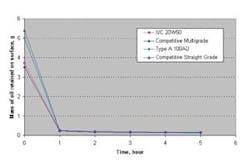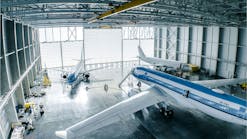Aircraft engines are built to be used on a regular basis, so any length of inactivity must be met with proper maintenance planning to ensure the engine remains in proper working order. Although experts recommend taking a plane up at least once a week for 30 minutes to an hour to prevent engine problems, many pilots in today’s economy have been forced to significantly reduce flight time due to tightened budgets and increased operating costs.
Rust and corrosion prevention
Rust does happen. In some cases it will form because the engines aren’t flown long enough to evaporate the water generated from condensation or blow-by from the combustion process. However, rust generated in this manner is the exception, rather than the rule. The most common cause for rust is improper aircraft storage. There are several different ways to help prevent rust and pilots and technicians must be familiar with these tactics if they plan to store an aircraft for longer than a few weeks. Preservative oils protect aircraft piston engines from rust and corrosion in a manner that standard aviation engine oils do not. These preservative oils are specifically formulated with robust corrosion inhibitors that allow the lubricant to chemically protect metal parts, resulting in a superior barrier against rust and corrosion. Such preservative oils, however, are not suitable for extended flight hours since they don’t contain the ashless dispersant additive package that protects engines during normal use. When preparing for storage, it is highly recommended that you drain and replace the existing oil with the preservative oil, and then fly the aircraft for at least 30 minutes or more to fully flush any remaining oil and circulate the new fluid throughout the engine to coat all engine parts. This simple step on the storage checklist will ensure much better engine protection results.
Basic principles
Whatever the type of operation or reason for storing an aircraft, there are several principles that should be followed to ensure your investment is adequately protected based on one of the following operating conditions:
Frequently flown: If your plane is flown several times a month, for periods longer than one hour, there is little, if any, need for additional rust protection. Phillips 66’s 30 years of experience indicates the existing rust-inhibiting properties of its ashless dispersant conventional oils perform very well for preventing rust in this type of service.
Infrequently flown: Phillips defines an infrequently flown plane as one that sits for several weeks to a month or more. We recommend that if you’re more than halfway through the normal engine oil drain interval, change the oil and fly the plane to circulate the fresh oil through all the bearings and valve train. Parking the plane with fresh oil will greatly reduce the likelihood of any bearing corrosion that may result from contaminated or acidic used oil.
Infrequently flown with significant intervals (such as winter months) of non-use: The use of a preservative oil can significantly improve protection against rust when used as a top-off with conventional aviation oil. We recommend adding 10 percent of aviation anti-rust oil 20W-50 to the engine oil and flying it for 30 to 60 minutes to allow good distribution of the antirust additive before parking the plane.
Long-term storage: More than three months of continuous storage and the engine should be treated to a full change of preservative oil. Drain the crankcase and refill with straight anti-rust oil then fly the plane for at least an hour and park it taking all other steps for long periods of storage such as covering the exhaust. No matter where a plane is stored, critters and insects can pose just as big a threat to aircraft parts as rust and corrosion. Wasps and small birds are notorious for building nests within exposed areas of the exhaust and exhaust valves. When these nests go unnoticed by pilots or the maintenance staff, they can be ingested when the engine is powered up, resulting in significant damage to critical engine parts and also jeopardizing the safety of those onboard. During extended storage periods, every opening on the aircraft’s exterior should be carefully sealed to ensure nothing can fly or crawl into the plane. Additionally, when preparing a stored aircraft for flight, checking for such nests is a crucial step prior to operation.
Anti “scare tactic” anecdote
Rust does not always form in short periods of time. Phillips 66 once shipped an engine that had been using Phillips 66 X/C® 20W-50 from England, by boat, to Mobile, AL, for a condition report. In the shipping process the engine was misplaced. Months later, the engine was located on an outdoor loading dock, completely exposed to the elements.
Arrangements were then made to deliver the engine to Mobile for the disassembly and, to everyone’s surprise, there was no rust to be found in the crankcase or on any of the internal oil-wetted parts.
Laboratory test methods for rust and corrosion
It may be helpful to understand the type of bench-testing that can be a good indicator of the rust-prevention properties of aviation engine oils. One aggressive lab test for rust and corrosion prevention is the Turbine Oil Rust Test — ASTM D665 (also known as the Saltwater Spindle Test). The standard test consists of immersing a clean and polished steel rod into a mixture of 90 percent oil and 10 percent water or saltwater solution. Part A of the test uses distilled water while Part B uses synthetic seawater (containing sodium chloride, magnesium chloride, sodium sulfate, and a number of other ingredients in addition to the water). The mixture is stirred, with heat (140 F), for four hours, after which the steel rod is examined for evidence of rust.
Blind testing
Two blind samples were submitted to an independent lab that tested them in the Turbine Oil Rust Test, ASTM D665, Parts A and B. The two samples consisted of Phillips 66 X/C 20W-50 and a competitive multigrade product. Test results showed no corrosion and no staining for either of the samples. This test demonstrates that Phillips 66 X/C 20W-50 has good rust-inhibiting properties to protect steel under these adverse conditions.
The ASTM D665 test is not designed to demonstrate long-term storage protection, but it does indicate that the corrosion protection of passing oils is equivalent to that of rust- and oxidation-inhibited steam turbine oils.
Monograde vs. multigrade oil film retention debate
A persistent perception in the aviation community is that monograde, commonly referred to as straight-grade, aviation engine oils adhere to engine parts better than their multigrade counterparts, thus providing better protection during periods of inactivity. While it may make initial intuitive sense that a thicker straight-grade oil would remain on engine components longer than a multigrade oil, the simple fact is that all aviation engine oils drain off the parts down to a residual oil film thickness of 3 to 4 microns (25 microns = 1/1,000 of an inch) after just a few hours — regardless of the brand or viscosity of the aviation engine oil tested. So the idea that one achieves greater oil retention with single grade oils is a busted myth. The proven advantage of multigrade oils is that they result in faster lubrication at startup when most wear occurs, they exhibit better high-temperature protection in the piston ring belt area, and provide significantly cleaner engine operation than comparable straight-grade oils.
Final words of wisdom
Regardless of the reasons for a plane being stored, always plan ahead so that no step of the process is missed, and overestimate the anticipated storage time period in the event the aircraft needs to sit longer. While there are many components to proper aircraft storage, the process is easily manageable when broken down in a few simple steps and is critical to the long-term health of an airplane engine.
Harold Tucker is director of technical information and training, ConocoPhillips Lubricants.







